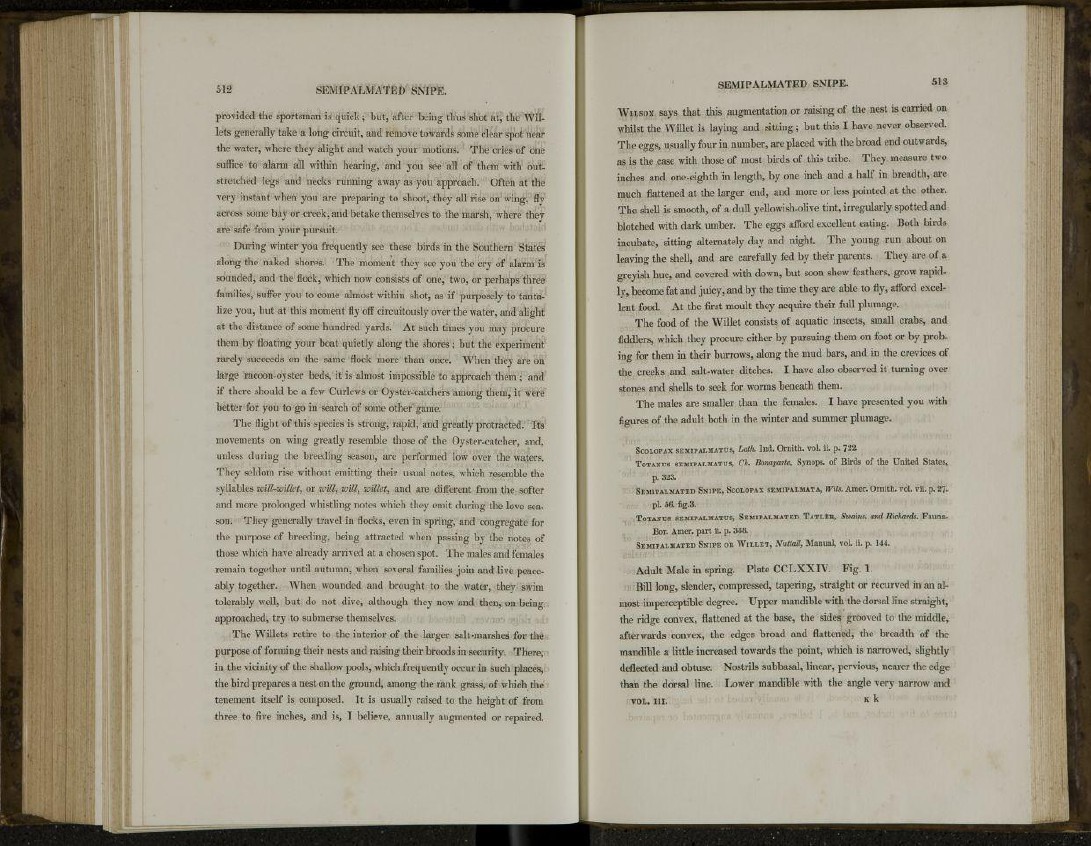
SEMIPALMATED SNIPE.
provided the sportsman is quick; but, after being thus shot at, the Willets
generally take a long circuit, and remove towards some clear spot near
the water, where they alight and watch your motions. The cries of one
suffice to alarm all within hearing, and you see all of them with outstretched
legs and necks running away as you approach. Often at the
very instant when you are preparing to shoot, they all rise on wing, fly
across some bay or creek, and betake themselves to the marsh, where they
are safe from your pursuit.
During winter you frequently see these birds in the Southern States
along the naked shores. The moment they see you the cry of alarm is
sounded, and the flock, which now consists of one, two, or perhaps three
families, suffer you to come almost within shot, as if purposely to tantalize
you, but at this moment fly off circuitously over the water, and alight
at the distance of some hundred yards. At such times you may procure
them by floating your boat quietly along the shores; but the experiment
rarely succeeds on the same flock more than once. When they are on
large racoon-oyster beds, it is almost impossible to approach them ; and
if there should be a few Curlews or Oyster-catchers among them, it were
better for you to go in search of some other game.
The flight of this species is strong, rapid, and greatly protracted. Its
movements on wing greatly resemble those of the Oyster-catcher, and,
unless during the breeding season, are performed low over the waters.
They seldom rise without emitting their usual notes, which resemble the
syllables will-willet, or will, will, willet, and are different from the softer
and more prolonged whistling notes which they emit during the love season.
They generally travel in flocks, even in spring, and congregate for
the purpose of breeding, being attracted when passing by the notes of
those which have already arrived at a chosen spot. The males and females
remain together until autumn, when several families join and live peaceably
together. When wounded and brought to the water, they swim
tolerably well, but do not dive, although they now and then, on being
approached, try to submerse themselves.
The Willets retire to the interior of the larger salt-marshes for the
purpose of forming their nests and raising their broods in security. There,
in the vicinity of the shallow pools, which frequently occur in such places,
the bird prepares a nest on the ground, among the rank grass, of which the
tenement itself is composed. It is usually raised to the height of from
three to five inches, and is, I believe, annually augmented or repaired.
SEMIPALMATED SNIPE. 513
WILSON says that tins augmentation or raising of the nest is carried on
whilst the Willet is laying and sitting; but this I have never observed.
The eggs, usually four in number, are placed with the broad end outwards,
as is the case with those of most birds of this tribe. They measure two
inches and one-eighth in length, by one inch and a half in breadth, are
much flattened at the larger end, and more or less pointed at the other.
The shell is smooth, of a dull yellowish-olive tint, irregularly spotted and
blotched with dark umber. The eggs afford excellent eating. Both birds
incubate, sitting alternately day and night. The young run about on
leaving the shell, and are carefully fed by their parents. They are of a
greyish hue, and covered with down, but soon shew feathers, grow rapidly,
become fat and juicy, and by the time they are able to fly, afford excellent
food. At the first moult they acquire their full plumage.
The food of the Willet consists of aquatic insects, small crabs, and
fiddlers, which they procure either by pursuing them on foot or by probing
for them in their burrows, along the mud bars, and in the crevices of
the creeks and salt-water ditches. I have also observed it turning over
stones and shells to seek for worms beneath them.
The males are smaller than the females. I have presented you with
figures of the adult both in the winter and summer plumage.
SCOLOPAX SEMIPALMATUS, Lath. Ind. Ornith. vol. ii. p. 722.
TOTANUS SEMIPALMATUS, Ch. Bonaparte, Synops. of Birds of the United States,
p. 323.
SEMIPALMATED SNIPE, SCOLOPAX SEMIPALMATA, Wils. Amer. Ornith. vol. vii. p. 27.
pi. 56. fig.3.
TOTANUS SEMIPALMATUS, SEMIPALMATED TATLEH, Swains, and Richards. Fauna-
Bor. Amer. part ii. p. 308.
SEMIPALMATED SNIPE OR WILLET, Nuttall, Manual, vol. ii. p. 1 4 4.
Adult Male in spring. Plate CCLXXIV. Fig. 1.
Bill long, slender, compressed, tapering, straight or recurved in an almost
imperceptible degree. Upper mandible with the dorsal line straight,
the ridge convex, flattened at the base, the sides grooved to the middle,
afterwards convex, the edges broad and flattened, the breadth of the
mandible a little increased towards the point, which is narrowed, slightly
deflected and obtuse. Nostrils subbasal, linear, pervious, nearer the edge
than the dorsal line. Lower mandible with the angle very narrow and
VOL. in. K k